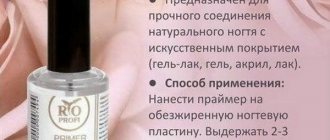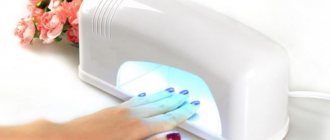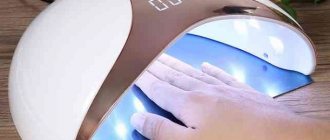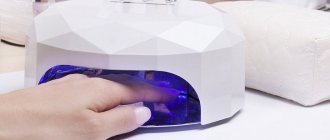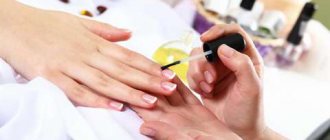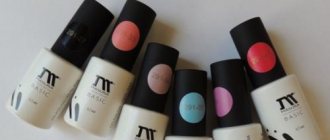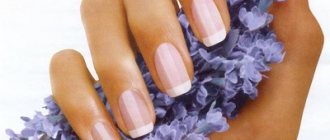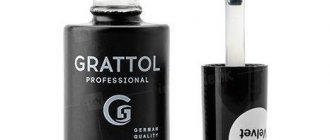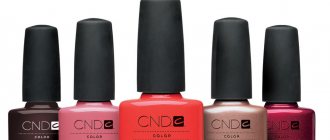Nail modeling is a complex and meticulous procedure that requires special preparation of the nail plate. To work with nails, several types of products are used, which serve as the foundation for applying acrylic and gel coatings. One such coating is a primer. Everyone who decides to paint their nails should know what it is and why it is needed.
Nail primer: what is it?
A novice manicurist needs to know what a nail primer is. Any material is needed for something, serves certain purposes. Translated, the name of this product means “initial”, “first”. It is used to remove the greasy layer, clean and dry the plate area, which helps to evenly distribute subsequent layers of cosmetics.
Primer composition
The consistency of the primer is similar to ordinary water or gel. Sometimes it has a smell similar to vinegar, but sometimes it is odorless.
Primers are divided into two classes:
- acid;
- acid free.
The product is sold in glass or plastic bottles with a cap on which a brush is attached. The composition of ingredients does not contain unnecessary colors and flavors to reduce the likelihood of allergies.
Acid based primer contains methacrylic acid (30% to 100%). It promotes adhesion of the nail structure to the applied materials. This product is often used when applying acrylic to the nail. In addition, the composition contains chemical components such as ethyl acetate and 2-hydroxyethyl methacrylate.
Ethyl acetate has a pleasant fruity aroma, softens the skin and serves as a solvent. These substances affect the quality and effectiveness of the composition. Acid is very drying, so it is recommended to use a product based on it on oily and upward-growing nails.
A distinctive property of the primer is quick drying. It leaves a pale gray residue once it has appeared, which means the next coat is ready to be applied. When interacting with the skin, it can cause an allergic reaction, expressed in hyperemia and irritation.
A primer that does not include acid is safer, but is inferior in terms of adhesion. Professionals recommend choosing it if you are performing a manicure with gel polish.
Which primer should you choose?
Whether it is necessary to dry the primer in a lamp depends on which manufacturer you choose. We bring to your attention primers that are offered by manufacturers from different companies.
- Acid primers are most often used for nail art. These products are made on the basis of methacrylic acid. The product used is quite caustic and aggressive, so you need to be as careful as possible when working with it. Many manufacturers say that the primers presented do not put any stress on the nails, but rather improve the condition of the nails and also increase the quality of the nail plate. Among these primers, there are those that dry perfectly even without the use of a lamp, that is, in air;
- acid-free primers are cheaper in cost and available when working with a nail technician. In addition, the material is more delicate, which makes it possible for even beginners to work with it. But if you decide to give your client an acrylic coating, then acid-free primers cannot be used for extensions. These primers must be dried in a lamp without fail. You can use acid-free primers if you plan to do a gel coating. This primer does not penetrate deep into the nails, which makes it possible to keep the nails in good condition, even if the primer is applied repeatedly to the nails. When applied to nails, a sticky layer is formed that does not need to be removed, as it creates good adhesion between the nail plate and the applied material;
- pre-primer is a common composition that is most often used to pre-coat the nail plate. But this product cannot be used as a complete coating for the nail plate. If an acrylic coating is required, such a primer cannot be used.
Choose the right primer; it will help you create a high-quality manicure in the shortest possible time, which will serve your client for a long time.
How does a bonder differ from a primer?
It is not enough to know what a nail primer is to perform a manicure at a professional level. For proper extension you will also need a bonder. It is used to treat the nail before applying a coating with decorative properties.
The bonder determines the strength of the connection between the nail and this coating. It helps to create a solid base and make the work high-quality and durable. The primer prepares the work surface for uniform application - that's what it's for.
Bonder guarantees high-quality grip. It does not contribute to degreasing, disinfection and dehydration, but creates a protective film on the surface.
The bonder has a sticky texture and, after application, dries under a lamp for about 3 minutes. Used after the primer.
Types of primers
Pre-primer is a delicate product with protective functions. Some call it bond. It does not contain coloring or flavoring components, it is gentle on the nail and does not penetrate into the inner layer. Prep degreases well.
When doing extensions, it is often applied before acidic products in order to remove the fatty layer well. With prolonged use, it does not dry out or make nails brittle.
The primer helps the nail not to flake or turn yellow.
Prep cannot be used for extensions, because it gives weak adhesion.
Application:
- as a base for traditional varnish;
- as a protective agent for damaged nails;
- a product that promotes additional adhesion of the nail to the upper artificial layers (especially important for people suffering from hyperhidrosis);
- with intolerance to artificial materials.
Acid primer is intended for procedures with healthy nails. It softens the nail, which improves adhesion. It is forbidden to apply it to weak, diseased and brittle nails, as it is toxic. It is not recommended to apply the product liberally or several times in one procedure. Often used for extensions using acrylic-based materials.
An acid-free primer (ultrabond) has a neutral and gentle effect on the natural structure, but performs the same tasks. The product is more suitable for removing fat and dehydration. It is used both under gel and for pedicure and manicure with bio-varnish.
The main differences between a primer and a base
- A primer is not always and not necessarily used. Its use depends on the preference of the manicurist. The base is a necessary and mandatory element of a manicure using gel polishes or nail extensions. You can do without a primer, but you can’t do without a base.
- The primer performs protective functions against the penetration of destructive substances and coloring pigments into the nail. Also, a primer is a “glue” that allows the base coat to adhere even more tightly to the natural nail. The base compacts the nail plate and makes the nail smooth for the subsequent application of a colored layer of gel polish. Both of these substances have completely different functionality.
- The primer can have the consistency of a slightly thick liquid that needs to be dried in ultraviolet light, or it can be an alcohol-acid liquid that instantly evaporates in air. The gel base is always quite thick, easily spreads over the nail, transparent, without a sharp chemical odor, and after polymerization it leaves a sticky layer on top for a tighter adhesion to the colored layer.
- The primer is used to a greater extent when extending nails; after this layer, a building gel is usually applied, which is much thicker and denser in consistency than a regular base. Therefore, for it you need to prepare the nail in a special way, which is what the primer does. It allows the scales of the stratum corneum of the nail to rise slightly, which ensures reliable adhesion. The base for gel polish is softer than the gel builder; moreover, the layers of artificial substances when covering with gel polish are much thinner than when applying extensions. Thus, the nail does not require very strong adhesion of the base to the nail plate, and you can avoid overloading the nail with primer, drying it out excessively.
Beauty and fashionComment
The best companies
What is a nail primer and why it is needed is now clear, all that remains is to review popular products.
Lady Victory acid-free primers perfectly degrease, provide reliable adhesion and prevent peeling of the coating. Ideal for beginner manicurists due to the absence of acidic substances in the composition. Price range from 80 rub. up to 350r. Manufacturer – China.
Le Vole Ultra Bond is ideal for working with gel and acrylic. The compositions of this brand disinfect and clean the nail well, while maintaining the natural pH level. Price range from 250 rub. up to 400 rub. Manufacturer – USA.
Kodi Professional Ultrabond has a gentle composition, without methacrylic acid. Used when working with gel and for acrylic extensions. Average price – 450 rub. Manufacturer – USA.
EZ Flow produces products without dyes or fragrances. The brand's primer dries quickly, leaving a white residue. The brand produces all types of materials for working with different nail coatings. Production - USA. Price range from 500 rub. up to 1100 rub.
IBD has been known on the market for over 30 years. The brand produces products suitable for people with hyperhidrosis and very brittle nails. IBD stick contains methacrylic acid, which prevents peeling of materials. Product cost from 300 rub. up to 900 rub. Manufacturer – USA.
Runail Professional Primer Acrylic System produces a product for acrylic extensions. Has excellent adhesive ability. Manufacturer – Russia. Price from 200 rub.
Yoko APR-15 is suitable for both gel and acrylic. This primer is acid based and its adhesive properties are significant. Price 150 rub. Manufacturer – Russia.
TNL Professional is also used for strong adhesion of nail and extension materials. The brand produces both primers with and without acid. Cost - from 180 rub. up to 240 rub. Production - South Korea.
Bluesky reduces the likelihood of coating peeling and increases adhesion. It is combined with both gel and acrylic, and is also used when coating with gel polish. There is no methacrylic acid among the ingredients. Price range from 140 rub. up to 250 rub. Production is located in China.
Irisk is a professional gel-free primer. Produces products for acrylic and gel.
Price range from 150 rub. up to 440 rub. Made in the USA. Available in bottles with volumes from 10 ml to 15 ml. The brush is usually included.
What is an acid-free primer?
Acid-free primers either contain no acid at all or have a small amount of it. If there is such a component in the composition, then it is usually represented by methacrylic acid. Preparations of this type are often called ultrabonds.
An acid-free product is used for nail extensions or strengthening with the help of:
- Biolac;
- Shellac;
- Gel varnishes.
Accordingly, this composition is not suitable for acrylic extensions. Often people try to save money on such a product and use improvised means in the process. But as practice shows, only a primer can simultaneously degrease and disinfect the nail, as well as ensure the adhesion of the artificial material to the nail plate.
The composition is designed to eliminate excess fat, as well as lift the upper scales of the nail. Therefore, when applied, the nail is literally covered with a white coating - this is a completely normal and expected reaction.
For those who want to learn more about what makeup base primer looks like and how it is used.
Thus, the artificial material is perfectly attached to the plate and lasts much longer. When using improvised means such as alcohol or vinegar, such an effect cannot be achieved.
Among other things, an acid-free primer has a protective effect on the nail against the penetration of pathogens into the nail structure, as well as against the occurrence of yellowness and delamination. If this procedure is neglected, a greenhouse effect develops under the coating layer, which allows fungi and bacteria to develop and penetrate deep into the structure of the plate.
You may also be interested in information about what a gel polish primer looks like and how to use it correctly.
The video shows a detailed description of the product:
The strength of the adhesion and protection of the nail depend on the quality of the product, as well as on how the composition is applied to the nail.
An acid-free primer, when used before gel extensions, makes it possible to achieve the strongest possible adhesion of the material to the plate. Accordingly, this will reduce the likelihood of cracks and chips. It will also not harm thin, sensitive and brittle nails. It helps to degrease the keratin layer of the nail, but does not disrupt the pH level. The same type of product does not cause rapid corrosion of the skin and etching of the nail, but if it gets on the surface, it is still recommended to wash it with soap.
The product dries without ultraviolet radiation, which is also an undeniable advantage. But on the other hand, this product is slightly less effective than an acidic one. Therefore, before purchasing, you should decide what kind of effect you want to achieve, as well as how safe the nail composition should be.
But whether a primer is necessary for gel polish and whether it can be replaced is indicated here.
Primer for gel polish and shellac
What a nail primer is and why it is needed has already been explained, and from this it becomes clear that its use is mandatory.
The product disinfects and removes excess moisture from the nail plate, which saves from various fungal diseases, because if a humid environment forms under the material, this will promote the development of pathogenic bacteria. The primer also increases the service life of the decorative coating.
Experts recommend using an acid-free product under shellac, so your nails will remain healthy after the manicure is removed.
Before using gel polish, the primer can be neglected if the client has dry and non-greasy nails. If a client suffers from hyperhidrosis, applying primer is a necessary ritual. It is also recommended to additionally protect nails that are brittle.
What is a primer?
Primer is a liquid with a strong alcoholic odor that is used as an additional nail degreaser and as a primer. And now the most interesting thing: primers are different. As can be logically noted from the above, this is a primer-degreaser and primer-primer.
A degreaser primer is a liquid based on alcohol and aldehydes, which completely removes the natural lipid layer from the nail. If you overuse it, you can easily dry out the nail plate, which will lead to separation.
Primer primer is a kind of “glue” that allows you to maximally adhere the base to the nail plate. In this case, the primer is a rather liquid but viscous substance. It is applied to the nail in a very thin layer over the entire surface. After this, the primer must be dried in an ultraviolet lamp for literally 10-20 seconds.
When applying nail extensions, the primer very often also serves as a protector, since it is a thin film between the real nail and the artificial coating, and prevents coloring pigments, as well as substances from the outside, from penetrating the nail plate, much less coloring it. This also applies to women who smoke.
Primer for regular varnish
This product can also be applied under regular varnish. It will serve as a primer layer, level the working surface of the nail and protect it from the penetration of chemicals. For those whose hands sweat a lot, the primer is a godsend. Under regular varnish, you can use a primer that does not contain acid.
Some manufacturing companies purposefully produce primers not only for gel and acrylic, but also for traditional varnish. For example, this is Yang nails with its acid-free product – Protein Bond. In tandem with varnish, you can also use a base coat.
Primer for gel nail extensions
The gel has large molecules, and they cannot adhere well to the nail scales. The primer fills in the unevenness of the keratin fibers. For gel modeling, you can purchase an acid-free product. Experts advise applying it in two layers when applying extensions to tips or forms.
The tips must be handled carefully; it is important that the product does not get on them, otherwise they will crack. The primer can be used for correction, but it can only be applied to a regrown nail. Contact with skin or artificial turf must be avoided.
What is a nail primer and what is it used for for gel polish?
Nail primer is a product with a watery or thicker consistency that is applied before using base. The liquid prepares them for coating with polymerizing compounds - flower beds, strengthening and lengthening gels. Here's what you need a gel polish primer for:
- removes fatty film from nail plates;
- makes them drier, that is, eliminates traces of sweat;
- lifts the scales of the top layer of nails, which ensures strong contact with the base and at the same time makes the surface smoother;
- helps to apply the polymerizing coating more efficiently;
- prevents nail splitting;
- prevents the appearance of yellow and whitish spots on them;
- serves to prevent the development of fungal infections.
Kinds
There are the following types of these funds:
- Nail prep for nails is a liquid that primarily protects them and gets rid of fat. It also has another name - bond. The effect on the nail plate is more delicate than that of other types, since the product works on the surface. But nail prep is necessary before using acrylic to create length, gel polish or regular polish, especially for hyperhidrosis. It is applied in these cases before the main primer.
- UV Gel Primer is the second layer of liquid, after which the base is used. It can be acidic or non-acidic. And the name comes from the fact that one of the products is used in the process of preparing for a gel polish coating or strengthening gel, which is dried in a lamp. Choose it according to the type of nails. The bottle with the product may also bear the designation Gel Polish primer - this means that it should be used under a polymerizing coating, and not with regular varnish.
Composition of the product
The composition of the liquid differs depending on its type, but it usually contains:
- ethyl acetate,
- butyl acetate,
- isopropyl,
- water,
- methacrylates.
Different types of products have different concentrations of the last component, and nail prep may not have it. The composition shows that all substances are drying, some can impart a noticeable odor to the liquid. Gel nail primers also come with or without residual stickiness. In any case, this layer should not be removed.
Watch the video about what a primer is and its composition:
How is it different from the base?
The primer differs from the base in that:
- is a pre-coating agent, while the base is its first layer;
- Dries in air, not in a lamp.
- prepares nails for applying a base, and it acts as a coupling for them and gel polish or other artificial material.
The differences are also noticeable in consistency - the primer is much more liquid.
What is the difference with a degreaser?
There is also a difference with a degreaser:
- it is used before the primer to wash away dust from nails and fingers after a manicure;
- its effect is much more superficial; the degreaser does not even affect the structure of the outer layer of the plates;
- it can remove stickiness from base or gel polish; primer is not suitable for this;
- it does not have adhesive properties.
A primer is a kind of degreaser, but only for nails; getting it on the skin is undesirable. Therefore, the composition is applied with a brush, which is usually found in the bottle. And for the degreaser, wipes that do not leave lint are used.
Differences with ultrabond
The primer also has a difference with ultrabond, but only the acid one:
- the first product contains fewer aggressive drying components, but it contains substances that enhance adhesion;
- because of this, ultrabond is sticky and takes longer to dry;
- It is better to use it for weakened, thin nails, since its protective properties are higher than those of a primer.
Is it necessary for shellac?
For shellac, a primer is also needed to make the coating last longer. Although, for example, when using CND flower beds this remedy is not provided. Nails are treated with Scrub Fresh degreaser and a base is applied. But the experience of many manicure lovers suggests that with a primer, shellac looks like new for more than 2 weeks. After all, this coating is less durable than gel polish.
How to use nail primer - step by step instructions
What a nail primer is and what it is needed for, a true professional knows very well and actively uses it in his work. But even a beginner, after studying the instructions, can master the correct application technique, and then it will bring the desired results.
- First, a regular manicure is done and the cuticle is pushed back. A warm bath is pre-prepared. Next, you need to remove the glossy shine with a buff. Do not remove too much, otherwise you may damage and weaken the plate. Dust is removed with a brush. Now apply the primer.
- A small amount of product is collected; excess liquid can be removed with a napkin or brushed from the brush into the bottle.
- The brush is placed in the center of the nail plate, you need to let the primer spread. A thin layer is applied, and the nail should be touched pointwise. Areas should not be left untreated. But an abundant layer will lead to the opposite effect, the nail scales will close.
- If the primer gets on the skin, you must carefully and carefully remove the product with a napkin or rinse the area under running water.
- The drying stage remains. There are several options: naturally, in a UV or LED lamp. Information on use can be found on the bottle or in the instructions. An acidic primer, when dried, gives a pale gray coating; an acid-free primer should dry well and not leave wet marks. The surface becomes rough to the touch.
- Now you can distribute the decorative coating.
- When applying gel extensions, the primer is applied before applying the base coat. If the system consists of three phases, then this will be the first layer. If this is a single-phase system, then the first layer is applied differently.
- The brush should be half dry, apply the product using rubbing movements. Then the gel is distributed and the hand is placed in the lamp.
- If tips are used, then a primer is also applied before the bonder.
- The system is as follows: first, degreasing is done with ultrabond, then a thin layer of acid-free product is applied and glue is applied.
- After application, the primer retains its active properties for 40 minutes, so it is recommended to apply it to 2-3 nails in stages.
FAQ
- Is it necessary to use a primer to degrease nails? The question often arises whether a nail primer is needed, and whether it is possible to do without it at all, because it is not included in gel polish starter kits. Answer: yes, but only if the coating holds up well without it. That is, by refusing to use a primer, you can get a shorter period of wearing gel polish. But for nail extensions, using a primer is a mandatory step.
- What is the difference between a primer and a nail base? This question may arise for beginners, since these are completely different concepts, although their function is very similar - ensuring reliable adhesion of the material to the surface of the nail. However, the primer is not an independent layer and does not dry in a lamp, while the base is part of a three-phase nail gel polish coating system, has a sticky layer, shine and polymerizes in a lamp. Its use is not necessary only if you use single-phase gel polishes (3 in 1 gel polishes), otherwise the technology for creating a long-term coating will be disrupted and the result may not be what you expect.
- Should nail primer be dried in a lamp? No, it is not necessary unless this is indicated in the instructions for use from the manufacturer. There are primers that need to be dried in a lamp, and this will definitely be indicated on the packaging.
- Which primer is better? I can’t undertake to recommend specific manufacturers, since I have tried a very limited number of them, but I would recommend buying a primer that does not require drying in a lamp - this will reduce your working time. Of those that I had, I liked the prep from Red Carpet Manicure the most: I have been using its small 10ml bottle for 2 years, and it dries in a matter of seconds - a white coating is visible on the nails immediately after applying the brush. Bonder from Ingarden dries in about 30 seconds and leaves a slight sticky residue - I use it with less durable gel polishes.
We invite you to familiarize yourself with ULTRASONIC FACIAL CLEANING. WHAT IS IT, STEPS, RESULTS PHOTOS BEFORE AND AFTER - BEAUTY SECRETS
https://www.youtube.com/watch?v=subscribe_widget
In this large article, I tried to sort out all the questions related to nail primer. If something remains unclear to you, ask in the comments.
Should I dry the primer in a lamp?
There are self-curing and light-curing primers.
Self-curing nail primers dry quickly. Everything is individual, depending on the manufacturer and the intensity of the product - on average from 5 to 60 seconds. There is no need to dry them in a lamp.
Some manufacturers produce products that are dried in a UV lamp. This is usually indicated in the accompanying information. Such primers have a thick and viscous texture, while others are liquid, like water.
It is important to follow the duration of exposure in the lamp indicated on the product, otherwise you can harm your nails. Some primers take a long time to dry.
The main thing is not to apply the next layer until the primer has dried.
Don't miss the most popular article in the section: How to extend nails with gel polish. Nail extension instructions for beginners. Photo.
Available about everything: what is a primer and how it is dried
Photo from the site: Manikyr.ru
Before you start figuring out whether you need to dry the primer in a lamp, it won’t hurt to first understand what it is, what types and types of substances exist. Manufacturers offer a simply colossal range of such products, and the various compositions require special treatment, and the technology for their use may differ significantly. This will determine whether the primer needs to be dried in a UV lamp, or whether you can simply dry it gradually in the open air.
Important
Translated from Latin, the word primer means “first,” which determines its use. In the field of nail art, a primer is a special composition that is applied to the nails immediately after preliminary preparation for its final dehydration and degreasing. Most often it is a liquid or gel that contains acids, but there are also acid-free formulations. Whether the primer is dried in a lamp or not directly depends on the composition of the substance.
Professional recommendations for working with primer
What is a nail primer and why it is needed should now be clear.
But it remains to learn a few more tips from the masters of the manicure industry:
- If the master has injured the cuticle and started bleeding, and there is no hemostatic agent on hand, you can use a primer, but there will be a strong burning sensation.
- If too much product is applied, the client may experience 3rd degree burns.
- Before applying the finishing layer, you can lightly walk the cuticle with the product. This will get rid of microcracks and detachments, and your nails will look good until the next extension.
- When using an acid primer, the periungual skin can be lubricated with a rich cream. This will protect against possible irritation and burning.
- You should avoid getting the primer on the tips during extensions.
- The product should be applied with a brush.
- If the nails are too elastic, apply an acid-based product along the end part and the free edge, and the rest with ultrabond.
How can I replace primer for gel polish?
If you know what a nail primer is, you can find a replacement for it. However, not many people know why it is needed. Homemade options can only dry and disinfect the surface being treated; adhesive properties cannot be achieved.
Vinegar (9%) removes remaining grease and promotes the evaporation of excess moisture, but it does not lift the nail scales and therefore does not increase the tenacity of the materials. Boric acid (3%) has antiseptic properties and slightly increases tenacity, but only a gel will do.
Nail polish remover, if it does not contain acetone, will dry your nails and increase their adhesive properties. You can work with it instead of a primer only if the composition does not contain oils.
Nail primer can be replaced with nail polish remover.
In addition, you can wash your hands thoroughly with laundry soap. This will help remove the oily layer, but the skin on your hands will suffer. 96% pure alcohol or lemon juice will do. All of the above options are applicable, but will not give a significant effect, such as that provided by a special product.
The primer protects your nails from diseases and allows you to prolong the joy of a first-class manicure. Nail art beginners need to learn in detail what a nail primer is, how to choose it according to the task, what it is for and how to use it.
How to dry primer and when to apply
The primer should simply be air dried. In order for the alcohol components of the liquid to evaporate faster, you need to place your hand on the table, palm down. It is better to keep your fingers open. And you need to try not to tilt your arm to the side. Don't shake your fingers either. If too much liquid is applied, it may spread unevenly on the nails.
The primer is used after a hygienic manicure is performed:
- nails are shaped;
- the overgrown part of the cuticle was removed, the pterygium was cleaned;
- the skin around the nails is sanded;
- The surfaces were treated with a buffer and wiped with a degreaser.
Applying primer is the next step. It is applied to clean nails, that is, there should be no sawdust or skin particles on their surfaces.
Look at the video about what a primer is, how to apply and dry it:
Useful videos on choosing and using nail primer
Which primer should beginners choose: acidic or acid-free:
Subtleties of using nail primer:
It is impossible to imagine beautiful well-groomed nails without a stylish original manicure. Every girl or woman strives to give herself a chic image with the help of a bright coating of nail plates. In most cases, nails have to be extended. Artificial nails require special care, but rarely does anyone know what products are needed for this and how to use them. One of these drugs is a primer, without which it is impossible to imagine proper care.
Primer action
First you need to understand what a primer is. This is a colorless liquid and is indispensable for nail extensions. Before applying it, the nail plates must be processed using a sanding file and given the desired shape.
The primer strengthens the gel after application and prevents it from peeling off. Artificial turf lasts longer and lasts longer. Many girls use a simple nail polish remover to degrease. A primer will also come to the rescue here; it perfectly disinfects and degreases the nail plates.
After washing your hands or special baths before a manicure, you should also use a primer; it will do a good job of removing dirt and preparing your nails for application. It can be either gel polish or simple polish.
There are three types of primers:
- acid-free (excellently cleanses, dries, an indispensable assistant for gel extensions);
- acidic (in most cases used for acrylic extensions);
- pre-primer (the most popular preparation, after it you can use other types of primers).
You need to apply a small amount, being careful not to get the product on the skin near the nail. This may cause a painful burn. It is better to use a small brush and apply a thin layer to your nails. You cannot apply several layers, the product will not only take a long time to dry, but can also ruin the entire manicure.
Be prepared for the fact that the drug has an unpleasant, pungent odor. It is better not to bring your nails covered with it close to your face and try not to inhale the fumes until everything has evaporated well. If you are allergic to odors, you may forever lose the desire to use this wonderful product.
Primer and base for nails: what is the difference?
If in makeup base and primer are synonymous, then in manicure they are two completely different things. But it is not at all critical for an “amateur” to confuse them with each other. The primer is usually used by professionals in salons. At home, one base for colored varnish is enough.
Before we start talking about the difference between a primer and a nail base, you need to understand what each of them is.
- The nail base looks like an ordinary transparent varnish, which, however, plays an important role. It helps prepare your nails for color coating: smooth their surface and fill in any unevenness. The varnish adheres better over the base and ultimately lasts longer. There are bases for both regular varnish manicure and for working with gel polish.
- A primer is usually a liquid product that cleans, degreases, and dries the nail plate. It does not remain on the nails as a separate coating. Unless we are talking about a special base with a “primer” function. It is usually a little denser and more stringy and needs to be dried under a UV lamp. A layer of such a base improves adhesion to artificial turf and, at the same time, protects the nail from the effects of chemical components “from above.” So most often the “primer” is applied when doing manicures with gel polish and when doing nail extensions.
From this alone it is clear that primer and base are not very similar products to each other, with different purposes.
The main differences between nail base and primer
1
If a nail base is a mandatory first coat when creating a manicure, then a primer is rather an additional product. In general, you can do without a primer. But professionals still prefer to use it.
2
Primer is, first of all, a product for salon manicure. The base is used both by masters in salons and by those who do their own manicures at home.
3
The products differ greatly in texture: the base is viscous, like regular nail polish, and the primer is usually liquid, almost like water.
4
Primer is, on the one hand, protection, on the other, “double-sided tape” for manicure. The base is a complete coating that physically protects the nails, evens out their surface and makes them smooth.
5
The base is necessary for all types of manicure. The primer is used mainly for nail extensions, separating their surface from the dense texture of the gel.
Did you know the difference between a primer and a nail base?
makeup.ru
